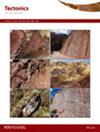南海北部的剥离和转移断层系统,对裂谷边缘三维构造划分的启示
IF 3.6
1区 地球科学
Q1 GEOCHEMISTRY & GEOPHYSICS
引用次数: 0
摘要
传统的 "贫岩浆 "和 "富岩浆 "边缘的二维裂解模式无法解释南海北部裂解边缘的地壳结构和推断的裂解过程。因此,"中间型 "术语被用于南中国海中北部,"宽断裂 "模式已被广泛接受。然而,关于南中国海的构造运动过程仍存在争议,至少存在五种截然不同的模式。我们汇编了覆盖整个白云和荔湾分盆地的三维地震资料和区域二维地震勘探资料,以研究这一 "宽断裂 "区域的构造结构和断裂方式。我们解释了两个构造风格截然不同的区段,它们被一条火山线和陡峭的转移断层分隔开来。白云分盆地由一个向陆倾斜的剥离系统控制。而荔湾亚盆地则是由一条长达 100 公里的向洋倾斜的凹上剥离断层形成的,该断层以 10°的低角度运作。该剥离系统的横向边界通过西侧的火山线/转移带和东侧的长达 190 千米的 N-S 向左侧走向滑动断层与周围的地质构造机械地分离开来。平面低角度剥离与之前解释的经典变质核心复合穹隆并不相似。我们的研究结果表明,在一个单一的 "宽断裂 "系统中存在一个波长为 60-80 公里的分段,表明在地壳延伸过程中存在复杂的三维断裂。这项研究证明,南中国海大陆边缘在运动学上具有复杂的变形风格,局部以剥离和转移断层系统之间的相互作用为主,这可能是其他边缘尚未认识到的。本文章由计算机程序翻译,如有差异,请以英文原文为准。
Detachment and Transfer Fault Systems in the Northern South China Sea, Insights Into 3D Tectonic Segmentation of Rifted Margins
The 2D rifting modes interpreted in traditional “magma-poor” and “magma-rich” margins cannot explain the crustal structure and inferred rifting processes in the northern South China Sea (SCS) rifted margin. The “intermediate-type” terminology has been therefore applied to the mid-northern SCS, where a “wide-rift” model has been widely accepted. However, the tectono-magmatic processes of the SCS are still debated and at least five contrasting models exist. We present a compilation of 3-D seismic volumes and regional 2-D seismic surveys covering the entire Baiyun and Liwan Sub-basins to investigate their tectonic structure and faulting style in this “wide-rift” region. We interpret two segments with contrasting tectonic styles separated by a volcanic lineament and steep transfer faults. The Baiyun Sub-basin was controlled by a landward-dipping detachment system. The Liwan Sub-basin, however, was formed by a ∼100 km-long oceanward-dipping, concave-up detachment fault working at a low angle of <10°. The lateral boundaries of the detachment system were mechanically decoupled from surrounding tectonics by a volcanic lineament/transfer zone to the west and a > 190 km-long N-S-trending left-lateral strike-slip fault to the east. The planar low-angle detachment does not resemble classical metamorphic core complex domes interpreted previously. Our results indicate a 60-80 km-wavelength segmentation within a single “wide-rift” system, indicating complex 3D rifting during crustal extension. This study supports that the intermediate SCS margin had a kinematically complex deformation style locally dominated by the interaction between detachment and transfer fault systems that might be yet unrecognized in other margins.
求助全文
通过发布文献求助,成功后即可免费获取论文全文。
去求助
来源期刊

Tectonics
地学-地球化学与地球物理
CiteScore
7.70
自引率
9.50%
发文量
151
审稿时长
3 months
期刊介绍:
Tectonics (TECT) presents original scientific contributions that describe and explain the evolution, structure, and deformation of Earth¹s lithosphere. Contributions are welcome from any relevant area of research, including field, laboratory, petrological, geochemical, geochronological, geophysical, remote-sensing, and modeling studies. Multidisciplinary studies are particularly encouraged. Tectonics welcomes studies across the range of geologic time.
 求助内容:
求助内容: 应助结果提醒方式:
应助结果提醒方式:


